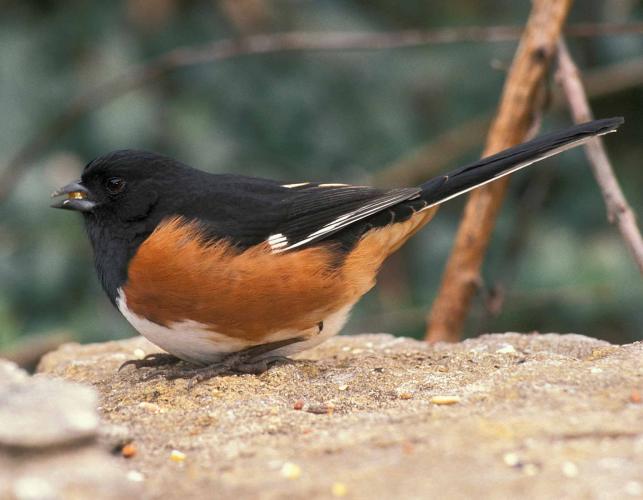
Eastern towhee adult upperparts are black in male, brown in female, with large white spots in the outer edges of the tail and on the primaries. Underparts are white, with rusty sides and flanks and tan under tail feathers. Song is two whistled notes followed by a higher trill, often described as drink your teeeeeeeee. Call is a rising towhee or chewink, often indistinct or slurred to che-ee.
Similar species: The closely related spotted towhee is an uncommon migrant in western Missouri, less common in eastern Missouri. The upperparts have white wingbars and white spots on wings, tail, and back. The American robin has gray upperparts with darker head, white around the eyes, and a yellow, not dark bill. The Baltimore oriole has underparts brighter orange, and wings with white wingbars.
Length: 8½ inches (tip of bill to tip of tail).

Statewide.
Habitat and Conservation
Eastern towhees live in thickets, brushy areas, glades, and streamside thickets. They often appear at bird feeders during migration. Towhee numbers have been declining in the past 50 years because thick, shrubby, brushy areas are shrinking: Today’s vast, unbroken croplands lack the patchwork of shrubby thickets and fencerows that used to be common; subdivisions and other developments are kept clean of brushy places; and yesteryear’s shrublands have matured into more open, less suitable forests.
Food
Towhees forage on the ground for insects, spiders, small reptiles, seeds, and berries. They scratch with both feet at once, by hopping backwards, hunting for prey on the exposed ground. If you stand quietly in the woods or near a tangled thicket, you might hear dry leaves being tossed about. Fallen leaves keep the ground moist, creating an excellent habitat for many insects. Try sifting some leafy soil through a piece of half-inch screening over a bucket, and see what you find.
Status
As a summer resident, common statewide but uncommon in the southeast. As a winter resident, uncommon in the east; rare elsewhere. Eastern towhee numbers are declining across their range. Eastern and spotted towhees used to be considered forms (subspecies) of a single species, the “rufous-sided towhee.” Ornithologists change common as well as scientific names to reflect the degree of relatedness. When the rufous-sided towhee was split into separate species, the common names were changed.
Life Cycle
Cup-shaped nests are built on the ground amid fallen leaves. They are made of bark strips, twigs, leaves and leaf stems, and so on, and lined with grasses, fine roots, and other fine materials. A clutch comprises 2–6 eggs, which are incubated 12–13 days. The young are mostly naked and helpless upon hatching but are ready to fledge after 10–12 days. There are 1–3 broods a year. Like many other ground-nesters, towhees use distraction displays to lure potential predators away from the nest site.
Human Connections
Preventing pet cats and dogs from roaming freely through the forests, woods, and thickets allows many ground-nesting birds to return to your area. Try keeping housecats indoors. Also, spaying and neutering prevents unwanted population growth of cats, which is a major survival problem for birds.
In old-time Ozark dialect, towhees were called "joree-birds."
Ecosystem Connections
When small and middle-sized predators are abundant, the reproductive success of ground-nesting species is usually greatly reduced. Skunks, raccoons, opossums, snakes, and other native animals take a reasonable share of towhees, but cats and dogs can upset the balance and locally eradicate towhees.










About 350 species of birds are likely to be seen in Missouri, though nearly 400 have been recorded within our borders. Most people know a bird when they see one — it has feathers, wings, and a bill. Birds are warm-blooded, and most species can fly. Many migrate hundreds or thousands of miles. Birds lay hard-shelled eggs (often in a nest), and the parents care for the young. Many communicate with songs and calls.

































